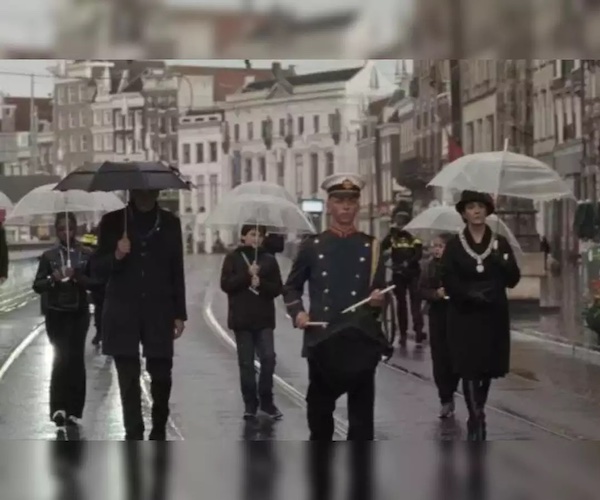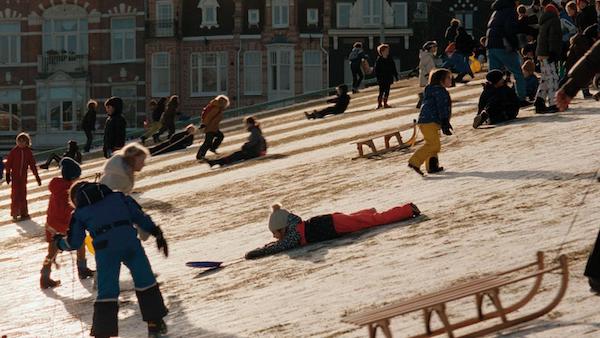Film Review: Steve McQueen’s “Occupied City” – It Wasn’t Just Anne Frank
By David D’Arcy
The disconnect between the Amsterdam of the past that is revisited and the scenes of life in the city today dramatize the fragility of memory and its erosion.
Occupied City, directed by Steve McQueen. Opens in New York on December 25.

A scene from Steve McQueen’s documentary Occupied City. Photo: A24
The documentary Occupied City surveys Amsterdam under the Germans from 1940 to 1945. At one point in the four-hour film, we are informed that Jewish families in the defeated city learned that Nazi officials did not track the race or religion of abandoned babies. So parents fearing deportation or worse left their babies as foundlings at hospitals. Somehow the Germans learned of this gambit and declared all foundlings to be Jewish, ending adoptions and inevitably dooming infants to deportation and certain death in Nazi camps.
Steve (Twelve Years a Slave) McQueen’s film has been distilled from Atlas of an Occupied City; Amsterdam 1940-1945, a massive book by McQueen’s wife, Bianca Stigter, who wrote the script. In this lengthy cinematic adaptation of an epic history, length becomes a relative term. In this ambitious cinematic adaptation of an epic history, length becomes a relative term. So does memory, as we hear a narrated catalogue of fear and murder over footage from today’s tidy and prosperous Amsterdam.
The Netherlands deported a higher percentage of Jews from its territory than any other country in western Europe. Anyone who resisted the Nazis risked being shot in the streets or in the dunes outside the city. Betrayal was a constant threat. “Jew-hunters” were paid for each person they turned in.
McQueen’s film is structured as an urban tour of the present day. No one, past or present, is interviewed. The approach is unvarying. The camera observes a place in Amsterdam, all sound taken from the present. Those who are filmed going about their everyday lives never engage with the camera. The narrator, Melanie Hyams, explains each location’s role during the Nazis occupation. Posh hotels became offices for the Nazi elite. The Concertgebouw, Amsterdam’s venerable orchestra, continued to perform under German control in its grand hall. The group’s Jewish members were ousted, some moving to a “Jewish” orchestra in another hall, until that stage was closed. The Concertgebouw’s conductor received a light punishment for playing for the Nazis. The higher one’s status, the lighter the penalty for collaboration tended to be.
An interrogation center where prisoners were tortured is now a girls’ school, where we watch blithe noisy teenagers. Jews who were forced to hand over the keys to their houses were relocated into districts where they were regularly rounded up and put on trains to camps, from which they were shipped to extermination centers in the East. At a jail housing political prisoners, Jews were packed into a tent outside the building and forced to recite the lines, “I’m a Jew, Beat me to death, it’s my own fault.”
From the beginning of the occupation, Jews were banned from city parks. The Nazis fine-tuned that proscription, also forbidding Jews from using the roads that went through parks. Fearing arrest, Jews hid and fled. Many were caught or given up, some by other Jews trying to avoid punishment and deportation. Many Jews killed themselves. The most common mode of suicide was gassing.

A scene from Steve McQueen’s documentary Occupied City. Photo: A24
Most of the buildings that we hear about were demolished, a major obstacle to preserving the memories of what took place in these places. While McQueen uses no archival footage — without photographic images, we’re forced to consider the deeper horrors of the occupation — he does take us to existing memorials. We see plaques in the ground and slabs of polished stone bearing names of the dead, so many names that they blur together, become undifferentiated to the point that they are harder to read than movie credits for minor players. We also see Holland’s King and Queen at sparsely attended mourning ceremonies for the war dead.
Occupied City is a composite of how grim daily life was in Amsterdam for Jews under the Nazis. Conditions worsened during the “Hunger Winter” of 1945, long after Paris was liberated (August 1944): temperatures fell steeply, and starving city dwellers left Amsterdam to trade their valuables with farmers for scarce vegetables and anything edible. The Jews who remained alive at that point, especially those hiding in the city, had the worst of it.
The disconnect between the Amsterdam of the past that is revisited and the chic hip Amsterdam of today dramatize the fragility of memory and its erosion. Note that the Netherlands just voted in a Prime Minister spouting right wing anger toward immigrants.
Bianca Stigter, who wrote the script, is the director and co-writer (with Glenn Kurtz) of Three Minutes: A Lengthening (2022), a feature-length meditation based on three minutes of a home movie shot in Nasielsk, a Polish town where almost all 3000 Jews were arrested and exterminated by the Nazis. She created that feature documentary (adapted from a book by Kurtz) out of the remnants of footage — three minutes of it — filmed by Polish-born tourists from America (Kurtz’s relatives) in a single visit one morning in 1938. Elegiac, hypnotic as it lingers on everyday encounters, the film offers a fragmentary glimpse of Jewish village life that no longer exists.
Stigter stretched out time in Three Minutes in order to show us a community before the Nazis ended Jewish lives that couldn’t be extended. In Occupied City, she and McQueen evoke the memories of a world that the Nazis and their Dutch collaborators were determined to destroy. The narration suggests that the Germans, with lots of Dutch help, were waging war against the Jews, not the Dutch.
There are some precedents for the cinematic strategy of Occupied City.
Obvious forerunners are Claude Lanzmann’s Shoah or Marcel Ophuls’s The Sorrow and the Pity, itself a long investigation of a single French city (Clermont-Ferrand) under the Nazis that draws on interviews and archival images. An under-recognized precedent that comes closer to McQueen and Stigter’s approach is Was Einmal War (What Once Was), a tour of Vienna by Sophie Lillie that reconstructs the geography of Nazi looting of Jewish property. Those stories would make for a long documentary.
McQueen and Stigter focus on killing and deportation to the death camps more than the theft of Jewish property and art. The latter was widespread in Holland. And the Dutch government took decades before it addressed those property crimes. Was the delay an amnesia that conveniently set in right after the war, as McQueen has said at screenings of the film? Or was it indifference, or a national habit that was hard to kick?
The Liro Bank, originally the Jewish-owned Lippmann, Rosenthal & Co., was taken over by the Nazis as an efficient way to seize Jewish bank deposits and property. These valuables funded the operations of the Westerbork transit camp, from which Jewish prisoners who figure in so many of those film’s stories were sent to death camps.
Some critics have been peevish in their complaints about the four-hour length of Occupied City. In interviews responding to them, McQueen stressed that “the subject matter tells me what to do.” I was left wondering, listening to the accounts of Nazi crimes and barbarity, how he kept the documentary so short.
David D’Arcy lives in New York. For years, he was a programmer for the Haifa International Film Festival in Israel. He writes about art for many publications, including the Art Newspaper. He produced and co-wrote the documentary Portrait of Wally (2012), about the fight over a Nazi-looted painting found at the Museum of Modern Art in Manhattan.
Tagged: Amsterdam, Holocaust, Nazi Europe, Nazi occupation, Occupied City, documentary
